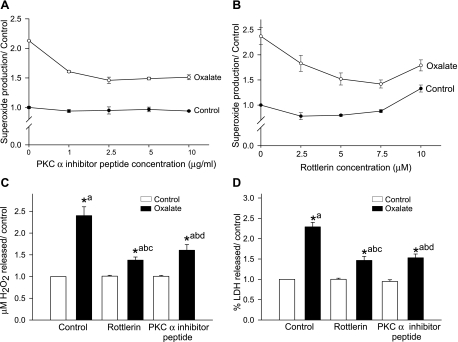Fig. 3.
Effect of PKC-α- or -δ-specific inhibitors on oxalate-induced ROS production and cell injury. A and B: both the PKC-α inhibitor inhibitor peptide (A) and the PKC-δ inhibitor rottlerin (B) attenuated oxalate-induced superoxide production. LLC-PK1 cells were pretreated with different concentrations of inhibitor peptide (1–10 μg/ml) or rottlerin (2–5-10 μM) for 30 min and then treated with 0.75 mM oxalate along with inhibitor for 3 h, after which superoxide production was determined. C and D: effect of PKC-α and -δ inhibitors on oxalate-induced H2O2 production (C) and LDH release (D). LLC-PK1 cells were treated with PKC-α (2.5 μg/ml) or -δ inhibitor (7.5 μM) for 30 min and then exposed to 0.75 mm oxalate along with inhibitors for 3 h, after which H2O2 and LDH were determined. DMSO was used as a vehicle. Data are normalized to control, and values are expressed as means ± SE. Comparisons shown: a, significant compared with vehicle-treated control; b, significant compared with oxalate; c, significant compared with rottlerin-treated control; d, significant compared with inhibitor peptide-treated control. *P < 0.05; n = 6.

